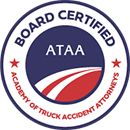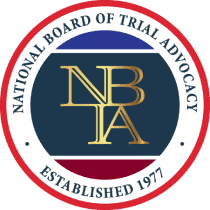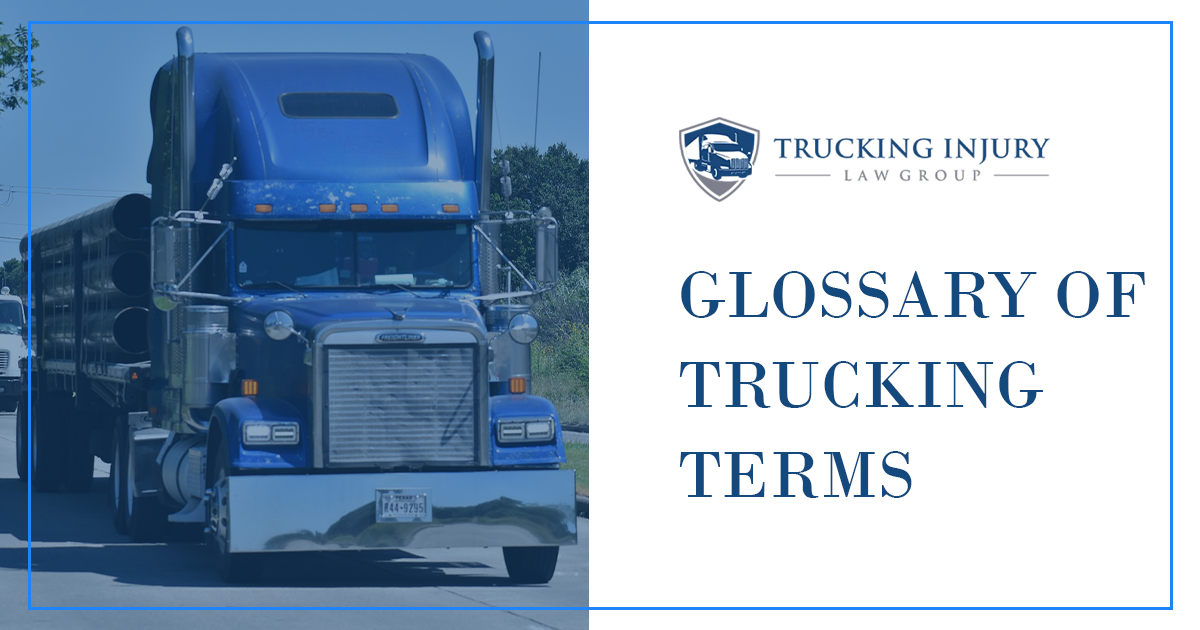Glossary of Important Trucking Terms
Whether you have been involved in a trucking accident or not, you have probably heard a few curious terms uttered by truckers.
Do you know the difference between the acronyms FMCSA and EOBR?
At the Trucking Injury Law Group, we are here to help demystify these words.
We understand that it can be difficult to understand a few technical terms prevalent in the trucking industry. Our trucking terms glossary can help you know more about these words that could be used in your case.
Let’s look at the most common terms.
Acronyms and Words Often Used in the Trucking Industry
In compiling our glossary of important trucking terms, we’ve added these words in alphabetical order to make it easier to search.
- ABS (Anti-lock braking system): This system monitors wheel speed and modulates braking force to prevent wheel lockup during heavy braking on slippery roads. It also helps drivers maintain control of the vehicle.
- Backhaul: A return trip carrying cargo after delivering a load to its destination.
- Big rig: This usually refers to a large commercial truck, especially those with 18 wheels.
- Black box: This is also an event data recorder (EDR). It is installed in commercial vehicles to record data on the vehicle’s operation.
- Blind spot: These areas near a commercial vehicle are not visible to the driver through the windshield, side windows, or mirrors.
- Bobtail: A tractor operating without a trailer.
- Cab: The front portion of the vehicle, which includes the engine, driver’s cabin, and controls.
- Cargo securement: The practice of properly securing cargo on a truck to prevent it from shifting or falling during transit.
- Cargo weight: The combined weight of all truck loads, gear, and supplies.
- Carrier: A company or individual that transports goods for hire.
- CDL (commercial driver’s license): This type of license authorizes an individual to operate commercial motor vehicles and buses that weigh over 26,000 pounds gross vehicle weight.
- CMV (commercial motor vehicle): This vehicle is used for business purposes to meet a certain weight or carry a certain number of passengers.
- Collision: An incident where a truck comes into contact with another vehicle, object, or obstacle, often resulting in damage or injury.
- Collision avoidance system: This system assists drivers in avoiding collisions by providing alerts or automatically applying brakes to prevent or mitigate accidents.
- Crashworthiness: The degree to which a truck or its components can withstand and protect occupants during a collision.
- Deadhead: A truck traveling without a load.
- Deadhead miles: The time spent traveling without cargo or a load.
- Delivery truck: A commercial vehicle transporting goods or cargo from a distribution center or warehouse to businesses or customers.
- Detention time: The time a driver waits to load or unload cargo.
- DOT (Department of Transportation): A state government agency responsible for regulating the transportation industry, such as Nevada DOT.
- Dump truck: A type of truck equipped with a hydraulic lift mechanism for tilting the cargo container backward.
- Emergency braking: The act of rapidly applying the brakes on a truck to avoid a collision or mitigate the severity of an accident.
- EOBR (electric on-board recorder): A cab-mounted device that electronically records truck speed, engine RPM, idle time, and other information.
- Fleet: A group of trucks or vehicles owned or operated by a single company.
- FMCSA (Federal Motor Carrier Safety Administration): The government agency responsible for regulating commercial motor vehicles in the United States.
- Following distance: The space maintained between a truck and the vehicle in front of it.
- Freight: Goods being transported or shipped via a truck.
- Guardrail: A barrier installed along the edge of roads and highways to prevent vehicles from leaving the roadway and potentially causing accidents.
- Head-on collision: A traffic accident that occurs when the front ends of two vehicles collide while traveling in opposite directions on the same road or highway.
- Hours-of-service: U.S. Department of Transportation safety regulations outlining the hours of service of commercial vehicle drivers for interstate operations.
- Jackknife: When the trailer of a truck swings out to form a 90-degree angle with the cab.
- Load shift: The movement of cargo within a truck during transit that can destabilize the vehicle and increase the risk of accidents.
- LTL (less than truckload): Shipments that do not require a full truck to transport.
- Maintenance records: The documentation of maintenance and repairs performed on a truck.
- Owner-Operator: A truck driver who owns and operates their own trucking business.
- Overloading: Loading a truck with more weight than it is designed to carry.
- Passenger bus: A large motor vehicle designed to transport passengers on fixed routes and operated by public transit agencies, tour companies, or private charter services.
- Preventive maintenance: The routine inspections and upkeep of a truck’s systems and components to identify and address issues before they lead to accidents or breakdowns.
- Rear-end collision: An accident that occurs when one vehicle collides with the rear end of another vehicle in front of it.
- Recovery services: Services provided to recover and tow trucks involved in accidents, clear debris from the roadway, and restore traffic flow.
- Reefer: Refrigerated trailer used for transporting temperature-sensitive cargo.
- Rollover: An accident where a truck tips over onto its side or roof, caused by excessive speed, sharp turns, or uneven road surfaces.
- Sideswipe: This occurs when the sides of two vehicles traveling in the same or opposite directions hit each other.
- Tractor-trailer: This is also known as an “18-wheeler” or “semi-truck,” and it is used for transporting goods over long distances
- Trailer: The rear portion of the vehicle that’s designed to carry cargo.
- T-bone accident: This can happen when the front of one vehicle collides with the side of another at a perpendicular angle, resembling the shape of the letter “T.”
- Underinflated tires: Tires with insufficient air pressure that can affect a truck’s handling and braking performance.
- Underride: A type of trucking accident where a smaller vehicle collides with the rear or side of a truck and becomes wedged underneath its trailer.
- Vehicle inspection: The examination of a truck’s components and systems to ensure they are in proper working condition.
Now that you’ve read this glossary of important trucking terms and understand them, you can better understand how they could relate to your accident case.
As always, if you still have questions about specific language in a police report or want to know more about your case, we always offer free consultations at Trucking Injury Law Group.






